|
Billed as the last great endurance event of the century, for cars built by
the owners, or by works, with components from many different standard production
cars, with new bodies. Some of these bodies 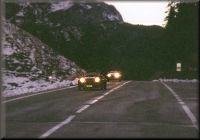 were replicas of older cars, and
others of new designs. It sounded like a great event to be part of, and it went
to many motoring venues that I had always wanted to visit. These were the Alpine
passes behind Monte Carlo, the Targa Florio course in Sicily, and of course the
famous Stelvio pass in Northern Italy, with its 48 hairpin bends!
were replicas of older cars, and
others of new designs. It sounded like a great event to be part of, and it went
to many motoring venues that I had always wanted to visit. These were the Alpine
passes behind Monte Carlo, the Targa Florio course in Sicily, and of course the
famous Stelvio pass in Northern Italy, with its 48 hairpin bends!
(Click
on pictures to view full size with captions.)
Marlin
Cars Ltd., of Crediton, invited me to be the navigator in the works entry, with
Mark Mathews, their Technical Director, to be the driver. The car we were to go
in was the Marlin Sportster, with its Vauxhall Omega V6 fuel injected engine and
gearbox, and Ford Cosworth suspension. A high powered car that stuck to the road
like glue. The car was painted yellow - but more of that later!
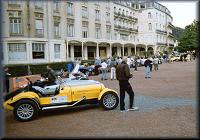 The start was from the town of Spa in Belgium on Saturday the 26th September,
so we left Tiverton early on the Friday morning, for the 500 mile drive via the
Channel Tunnel to scrutineering, (official checking of the car that it had all
its necessary documents and was outwardly mechanically sound). We also met the
60 other competitors, as well as the other two Marlins in our team. A Cabrio
from Falmouth and another Sportster from Brighton. The start was from the town of Spa in Belgium on Saturday the 26th September,
so we left Tiverton early on the Friday morning, for the 500 mile drive via the
Channel Tunnel to scrutineering, (official checking of the car that it had all
its necessary documents and was outwardly mechanically sound). We also met the
60 other competitors, as well as the other two Marlins in our team. A Cabrio
from Falmouth and another Sportster from Brighton.
We were number 51, which meant that our start time each morning would be
8.51, as the cars left at 1 minute intervals.
Enough
of the chatting, after scrutineering it was time for us to ‘sign on’, and
receive our ‘road book’ and to attend the drivers briefing. The road book
gave all the directions of the route to be followed, and the times that
'controls' that were to be visited were open. The distances between changes in
direction in the road book were correct to two decimal places. We like all the
other competitors, had previously fitted a very accurate distance recorder, that
gave total and intermediate distance, as well as average speed of the car. The
event was run at 30mph. (50kph.) average speed, but no marks were lost for early
or late arrival at controls. The average was
imposed in order that there were no excessive, or slow speeds!
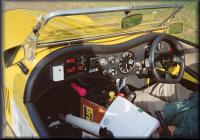 Up at 6.00 (5.00 English time!) to check the car and to
mark the maps from
the route book, then down to the town square in Spa for the start. We were off
at 8.51 and 354.12k’s(220 miles) to the next main control at Donon, west of
Strasbourg. The first secret control, to check that we were on the correct rout,
and not ‘cheating’ going down the motorways, was after 136k’s(85 miles),
and our card was stamped. Our card had to be stamped at each control, and all
the cards had to be filled in order to obtain a gold finishers medal. One
control missed - a silver, two a bronze, and any more, just a finishers medal. Up at 6.00 (5.00 English time!) to check the car and to
mark the maps from
the route book, then down to the town square in Spa for the start. We were off
at 8.51 and 354.12k’s(220 miles) to the next main control at Donon, west of
Strasbourg. The first secret control, to check that we were on the correct rout,
and not ‘cheating’ going down the motorways, was after 136k’s(85 miles),
and our card was stamped. Our card had to be stamped at each control, and all
the cards had to be filled in order to obtain a gold finishers medal. One
control missed - a silver, two a bronze, and any more, just a finishers medal.
We passed through the Moselle valley, where they were harvesting the grapes,
to make the wine, then through rolling countryside with farms. It was soon after
this that Mark thought that the gearbox was noisy on 4th and 5th gears.
Disaster! When we arrived at the Donon control, with plenty of time in hand, we
looked under the car and oil appeared to be leaking from the gearbox. We
therefore borrowed some thicker oil, and put that in, thinking that would
quieten it, and leaving the control on time, it did seam quieter, so we pressed
on to the overnight halt a Montbreliard, 191k’s away.
We passed through a textile area with a number of mills, and a textile
museum! It had been overcast at the start, and had rained on the way, which
meant the road was 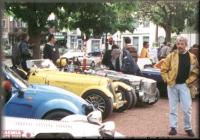 very slippery, so much so that one of the other competitors,
a Fisher (Lotus look alike), spun on a corner and finished up in the ditch at
the side of the road. Fortunately only the drivers pride was dented and the car
was soon back on the road, with the help of many other competitors that stopped
to help.
very slippery, so much so that one of the other competitors,
a Fisher (Lotus look alike), spun on a corner and finished up in the ditch at
the side of the road. Fortunately only the drivers pride was dented and the car
was soon back on the road, with the help of many other competitors that stopped
to help.
A little further on, disaster struck one of the large 1930 American style
Beaufords, when a French car came round a corner on the wrong side of the road
and demolished the front near-side of the Beauford - Although their rally was
over, luckily no one was injured. Many other cars were stopped at the scene, and
there was nothing more we could do, so we continued on to Montbrilard. The hotel
turned out to be on the outskirts of the town, and following the route book it
took us straight there. We had made this control on time and had the card
stamped at the other controls - one day complete- eleven to go!
Sunday arrived all too soon at 6.00, and still dark! The route had to be put
onto the map whilst Mark checked the car. The route was to be west of Geneva,
through the Jura mountains to Annecy, thence to Val d’Isere and over the Col d’Iseran,
at 9087 ft., and eventually to Briancon 560k’s (350 miles) away.
We left at our start time of 8.51, and the gearbox was quiet, and we were in
hopeful mood, but we had done only 50 miles, and the gearbox was making more
noise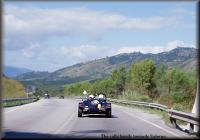 than the exhaust, and we realised that that was the end. We had taken both
motor and travel insurance to cover this eventuality, so the first job was to
ring them, and to organise to have the car repaired, or to obtain a hire car.
However, in due course, a lorry arrived, loaded the car and took us back the ten
miles to Le Russey where the lorry and car were locked in the garage, and we
were deposited at the local hotel. This was Sunday, and nothing further could be
done about mending the Marlin, or obtaining a hire car, and the rally was moving
away from us all the time. Ambition dashed - no driving over the French Alps, or
even round the Monte Carlo racing circuit. than the exhaust, and we realised that that was the end. We had taken both
motor and travel insurance to cover this eventuality, so the first job was to
ring them, and to organise to have the car repaired, or to obtain a hire car.
However, in due course, a lorry arrived, loaded the car and took us back the ten
miles to Le Russey where the lorry and car were locked in the garage, and we
were deposited at the local hotel. This was Sunday, and nothing further could be
done about mending the Marlin, or obtaining a hire car, and the rally was moving
away from us all the time. Ambition dashed - no driving over the French Alps, or
even round the Monte Carlo racing circuit.
As we sat in the hotel room, we made many ‘phone calls, Marlin Cars were as
disappointed about what had happened as we were, but we had to keep the other
Marlins in the event going, and therefore we would continue in a hire car, if
possible. Early Monday morning, we went back to the garage, and to speak further
with the RAC in order to organise the hire car.
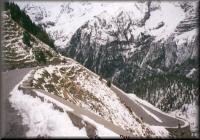 Eventually after we had shown the garage proprietor how to remove the
gearbox, we left by taxi for Portalier 30 miles away to collect the hire car.
This turned out to be a Peugeot 306, and of course, left hand drive! We
eventually left at about 4.00 to catch up the rally again at Marina di Massa on
the Italian Rivera. Consulting the maps, the route was through Lausanne and
Montreaux to the St Bernard pass, then down the motorway to Genoa and onto
Marina di Massa. (Which was the tunnel closed by the lorry fire? - the St
Gothard). Eventually after we had shown the garage proprietor how to remove the
gearbox, we left by taxi for Portalier 30 miles away to collect the hire car.
This turned out to be a Peugeot 306, and of course, left hand drive! We
eventually left at about 4.00 to catch up the rally again at Marina di Massa on
the Italian Rivera. Consulting the maps, the route was through Lausanne and
Montreaux to the St Bernard pass, then down the motorway to Genoa and onto
Marina di Massa. (Which was the tunnel closed by the lorry fire? - the St
Gothard).
The accommodation that night was a youth hostel, with eight to a room in bunk
beds. That evening one of the 2CV engined three wheelers returned to the event
after breaking down. They had called into a garage, with a very poorly engine.
The owner just happened to be the Italian chairman of the 2CV club, and he and
his men removed the engine and replaced it with one from his sons car, whilst
his wife fed them! The following morning they left to rejoin the rally. This
story was typical of many that happened.
As the day started, we were allowed to leave at our correct departure time,
and the marshals stamped our road book rather than the official route card.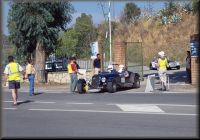 The
intermediate control was 409k’s away on the shore of a lake just north of
Rome, then a further 273k to the overnight halt at Monte Cassino, a total of 423
miles. The first stretch was past Pisa, and we saw the leaning tower for about
10 seconds, as we passed the entrance to the square. Soon after Pisa we passed
through a very strange valley with large cooling towers, and many steel pipes
coming down the sides of the hills. All very strange, as it seamed to be in the
middle of the countryside. Our only conclusion at the time, was that they were
harnessing the hot water form underground volcanic springs, The whole of the
centre of Italy seems to be of volcanic origins. The
intermediate control was 409k’s away on the shore of a lake just north of
Rome, then a further 273k to the overnight halt at Monte Cassino, a total of 423
miles. The first stretch was past Pisa, and we saw the leaning tower for about
10 seconds, as we passed the entrance to the square. Soon after Pisa we passed
through a very strange valley with large cooling towers, and many steel pipes
coming down the sides of the hills. All very strange, as it seamed to be in the
middle of the countryside. Our only conclusion at the time, was that they were
harnessing the hot water form underground volcanic springs, The whole of the
centre of Italy seems to be of volcanic origins.
So eventually to the lakeside control, where the people of Rome go to sail
and water-ski. We then turned east to miss out Rome, and then south to the
overnight halt at Monte Casino. About half way there, we had a call on the
mobile from one of the other Marlin team members, to say they were lost near the
centre of Rome! We suggested that they make for the main motorway going south,
and we would meet them at a service station, then continue with them to the
hotel.
The first part of the next morning was taken up by a drive into the town
square to show off the cars. In the square was a memorial to the soldiers in
World War ll, who died 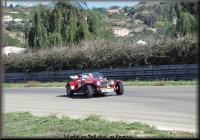 during the bombardment of the Monastery, which was being
defended by the Germans. The Monastery controlled the area for many miles around
because of its location on the top of a small mountain, and was attacked by the
allies until the Monastery itself was totally destroyed. It has since been
totally re-built, but the masonry still bore the scars. Leaving the square we
drove up to the Monastery, to see it at close quarters, - most impressive.
during the bombardment of the Monastery, which was being
defended by the Germans. The Monastery controlled the area for many miles around
because of its location on the top of a small mountain, and was attacked by the
allies until the Monastery itself was totally destroyed. It has since been
totally re-built, but the masonry still bore the scars. Leaving the square we
drove up to the Monastery, to see it at close quarters, - most impressive.
Soon, after a few photographs, we departed for the journey further south,
again through the volcanic region round the back of Vesuvius to Eboli, in land
from Salerno, 250k’s from Monte Casino. We thought that we would soon be on
some straight roads - not likely - at least 20 miles of no straights what so
ever! Most of the time we were passing through forests of sweet chestnuts, which
were ripe and were littering the roads. Eventually to the hotel in Scalea,
situated on the top of the foot of Italy - 300 miles from Monte Casino - but 250
miles if the roads had been straight!
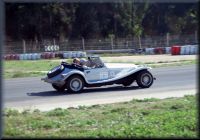 The following day a drive down the coast on straight roads gave some respite,
but soon it was onto the ‘wigglies’ again, over the mountains to Locri
situated on the instep of Italy, where we cooled of by paddling in the sea. Then
back to the north coast once more to drive to Villa San Giovani, to catch the
ferry to Sicily. There are about eight ferries that ply across and back,
departing every 15 minutes whether they are full or not for the three quarters
of an hour crossing. The following day a drive down the coast on straight roads gave some respite,
but soon it was onto the ‘wigglies’ again, over the mountains to Locri
situated on the instep of Italy, where we cooled of by paddling in the sea. Then
back to the north coast once more to drive to Villa San Giovani, to catch the
ferry to Sicily. There are about eight ferries that ply across and back,
departing every 15 minutes whether they are full or not for the three quarters
of an hour crossing.
Taking the designated route, it was a very steep wiggley climb out of Messina
with cobbles on the hairpin bends. The route along the north coast of Sicily was
very tedious as it seamed built up all the way along, but with little or no
industry. The views showed very pretty islands off the coast, which I had not
realised were there before. It was 9.15 when we arrived at the hotel, after
another 300 miles from Scalea, and the end of the first road book. The hotel was
very pleasant, it had a swimming pool which was excellent at midnight, after a
couple of beers!
The following day was a later start to drive the Targa Florio course. The
Targa Florio motor race, (for Florio’s Plate) was started in 1906 by Count
Florio, it was a 92 mile circuit, starting where we were due to start. The
circuit then went into the central mountains, as we would do, and then we turned
for the coast for our 43 mile lap, as was used in the 1960’s and 1970’s,
(the original went further out before returning to the coast and back to the
start).
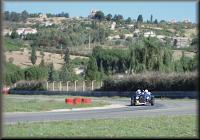 The 1912-14 race was round the whole of the island, but in the 1920’s it
reverted back to the original circuit. The race was dominated in the 1920’s by
Bugattis, and by Alfa Romeo in the 1930’s. After the war a circuit in the
south was used for two years when a new name of Ferrari won both events. The
circuit was then moved back to the north, and in 1955 Moss and Collins won in
the Mercedes. This was the era of the sports car races when Porsche and Ferrari
dominated. The last race was held in 1973, since when it has been used as a
round of the European Rally championships. The pits and the main grandstands are
still there, a little sun bleached, and the whole of the circuit is very
evocative. When one drives round, it is easy to imagine Bandini, Rodrigez, Von
Tripps, Collins and the rest, coming up behind to overtake in their Porsches and
Ferraris! The 1912-14 race was round the whole of the island, but in the 1920’s it
reverted back to the original circuit. The race was dominated in the 1920’s by
Bugattis, and by Alfa Romeo in the 1930’s. After the war a circuit in the
south was used for two years when a new name of Ferrari won both events. The
circuit was then moved back to the north, and in 1955 Moss and Collins won in
the Mercedes. This was the era of the sports car races when Porsche and Ferrari
dominated. The last race was held in 1973, since when it has been used as a
round of the European Rally championships. The pits and the main grandstands are
still there, a little sun bleached, and the whole of the circuit is very
evocative. When one drives round, it is easy to imagine Bandini, Rodrigez, Von
Tripps, Collins and the rest, coming up behind to overtake in their Porsches and
Ferraris!
The afternoon was spent relaxing and swimming, whilst others repaired their
cars. A Fiat engined Firecat took his car to be welded, and the owner of that
garage was an ex-works rally driver that owned a Ferrari engined special and an
Austin Ulster from 1930!
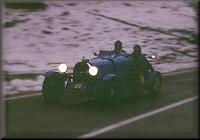 The drive south to the centre of Sicily and the Pegusa race circuit was on
deserted motorways, mainly built on stilts across the barren landscape. Some of
these motorways were only partially complete. The Pegusa racing circuit is still
used and D. Coutlhard holds the lap record in Formula 3. We went round to a
convenient marshals post to take photographs of Marlins in racing attitudes, for
future publicity pictures for the company. Each of the cars had two laps before
leaving for the next control. The drive south to the centre of Sicily and the Pegusa race circuit was on
deserted motorways, mainly built on stilts across the barren landscape. Some of
these motorways were only partially complete. The Pegusa racing circuit is still
used and D. Coutlhard holds the lap record in Formula 3. We went round to a
convenient marshals post to take photographs of Marlins in racing attitudes, for
future publicity pictures for the company. Each of the cars had two laps before
leaving for the next control.
This turned out to be the highest point to drive on Mt. Etna. The drive
there, seeing the lava flows and the partially covered houses, from the last
eruption in 1992, was awe inspiring. There have been rumblings since our return!
It was then 60 miles on the motorway to the ferry, passing the picturesque
mountain village of Taromina. Reaching the mainland again, the 375 miles back to
Scalea was mainly on motorways and main roads. During the early part of the trip
the motorway went through many tunnels as it hugged the coast.
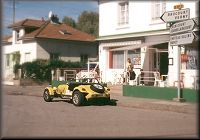 The next day we again followed the coast north and round the back of Salerno,
and onto the famous Amalfi drive. Being Sunday the traffic was very heavy, but
the views were spectacular. Similar to the North Devon coast line but bigger and
hotter! After Amalfi we turned inland to cross the Sorrentine peninsular - again
a wiggley road. Descending the other side we arrived in Castlemare, near Pompeii
at the foot of Vesuvious. Again spectacular, but the pace was relentless and we
pressed on to the overnight stop, again at Monte Casino. As we arrived the sun
was just setting, and approaching from the mountains we had memorable views of
the Monastery on top of the hill across the valley. The next day we again followed the coast north and round the back of Salerno,
and onto the famous Amalfi drive. Being Sunday the traffic was very heavy, but
the views were spectacular. Similar to the North Devon coast line but bigger and
hotter! After Amalfi we turned inland to cross the Sorrentine peninsular - again
a wiggley road. Descending the other side we arrived in Castlemare, near Pompeii
at the foot of Vesuvious. Again spectacular, but the pace was relentless and we
pressed on to the overnight stop, again at Monte Casino. As we arrived the sun
was just setting, and approaching from the mountains we had memorable views of
the Monastery on top of the hill across the valley.
The high light of the following day was to drive the 9.3 mile hill climb of
the Bruno Carrotti in the centre of Italy. This again had been used in the 1920’s
and 1930’s for competitions, but now was a wide public highway. There is a
pillar at the start line, and the road winds up the hill. The area is a ski
resort in the winter, but as we approached, the top was blanketed in fog!
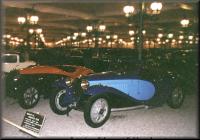 Once out of the mountains, it was on to the dual carriageway and through a
tunnel that was 2.5 miles in length, that had lay-bys in it in case of
breakdown. Over the mountain passes again, with yet more hairpin bends to drop
down to the Adriatic at Catollica, 300 miles from Monte Casino. Catollica is the
resort for the package holidays and there are many high rise hotels, most of
which were boarded up for the winter. Once out of the mountains, it was on to the dual carriageway and through a
tunnel that was 2.5 miles in length, that had lay-bys in it in case of
breakdown. Over the mountain passes again, with yet more hairpin bends to drop
down to the Adriatic at Catollica, 300 miles from Monte Casino. Catollica is the
resort for the package holidays and there are many high rise hotels, most of
which were boarded up for the winter.
We were due for a two hour stop the following day in Venice. Rainbows
punctuated the drive north along the coast. To start with we followed the route
of the Mille Miglia motor road race, that was again stopped in the late 1960’s.
We had time, just, to take a water taxi to St. Marks Square in order to take a
few photographs and return in the boat. All the buildings were exactly like the
pictures, and were all very ornate.
Back to the cars and north into the Dolomites. These mountains are unlike any
I have seen before, very steep sided and high ragged peaks, many with snow on!
The passes that we went over on the way to Cortina have been used since early
1930’s for rallying, the Cerdra, Duran, Giau were all crossed before Cortina
and our bed.
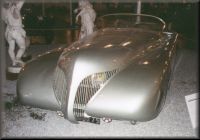 During the day, we had arranged to collect the Marlin the following day from
Le Russey, north west of Geneva in France. Cortina where we were, is in north
east Italy and there was Switzerland in the middle. We decided that we had to go
over the Stelvio pass (2760m-8970 ft.) on the way, so we left at 5.20 in the
morning, and arrived at the turning for the Stelvio at 8.00. During the day, we had arranged to collect the Marlin the following day from
Le Russey, north west of Geneva in France. Cortina where we were, is in north
east Italy and there was Switzerland in the middle. We decided that we had to go
over the Stelvio pass (2760m-8970 ft.) on the way, so we left at 5.20 in the
morning, and arrived at the turning for the Stelvio at 8.00.
Nothing had prepared us for this. There are 48 hairpin bends! All of which
are numbered, and number 48 is the one at the bottom. There are long stretches
of straight road between the hairpins, some of which are built out from the rock
face in order to allow a larger turning area. We stopped to take photographs at
various places and at one stage there was a wall of rock in front of us, covered
in snow, with the road zig zagging upwards. The road is all tarmac now, but when
used in the 1960’s it was still unmade! The drop down the other side into
Switzerland is exhilarating, but not as many hairpins, we then continued on
through Davos and Klosters, both of which were picture postcard Alpine villages.
From there it was motorway all the way to Neuchatel, and then just a few miles
to Le Russey and the car. We arrived at 3.30 after 470 miles!
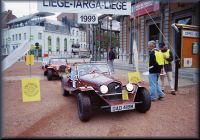 The car was ready,
we were told the problem had not been the gearbox, which had been
stripped and rebuilt, but it was the thrust bearing in the clutch that had
disintegrated. The noises that the gearbox made did not sound anything like this
at the time, and we wondered if when it had been
re-built, something in the gearbox was put back into place that was not previously correct. The car was ready,
we were told the problem had not been the gearbox, which had been
stripped and rebuilt, but it was the thrust bearing in the clutch that had
disintegrated. The noises that the gearbox made did not sound anything like this
at the time, and we wondered if when it had been
re-built, something in the gearbox was put back into place that was not previously correct.
We had done a total of 3,383 miles in the Peugeot in only nine days! It would
need a service! However, we had to take the Peugeot back 30 miles south to
Portalier before going north the 90 miles to Mulhouse and the control at the
famous Schlumph Museum that evening. This is an amazing place, an old textile
factory full of dozens of Bugattis, with seven 12 3/4 litre Royals, each worth
over one million pounds! Not only Bugattis, but many other types of cars, two
250F Maseratis and the re-built Mercedes Benz that crashed at Le Mans with
Peirre Levegh killing 70 people in 1955! Our dinner that night was kindly
provided by the museum, in their dinning room which over looks the museum, I
noted the menus had pictures of the Royals on them.
The last day of the rally took us back to Leige and started with a drive over
the Route de Cretes. This road is very scenic and winds through the forests as
it runs along the top of the hills 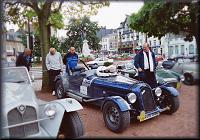 between the Rhine and the Mosselle. The 250
mile drive back to Spa and the finish was uneventful. We passed again through
the Mosselle wine region and eventually to the Spa Francorhamps motor racing
circuit. We were due to drive part of the circuit, which is a public road, but
it was closed, as there was some 'race testing' going on.
between the Rhine and the Mosselle. The 250
mile drive back to Spa and the finish was uneventful. We passed again through
the Mosselle wine region and eventually to the Spa Francorhamps motor racing
circuit. We were due to drive part of the circuit, which is a public road, but
it was closed, as there was some 'race testing' going on.
The return to the square we had left twelve days earlier, and so many hairpin
bends ago, was a strange feeling. Did it really happen? But what memories! The
evening dinner and presentation was sad for us , but the other Marlins did very
well in the prize giving. One won the event overall, and the other members of
our team won gold medals, so the Marlin spirits were not too forlorn.
The drive back home was wet, but the collection of a few cheap bottles from
the supermarket was fun. So we arrived back in Tiverton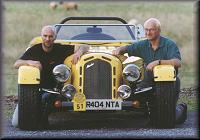 - to write it up, send
off the films to be developed, and save for the next! - to write it up, send
off the films to be developed, and save for the next!
Oh! I nearly forgot, the yellow hair. Well it was Marlin Cars idea, because
the event was being filmed for Sky television, to be shown in the New Year, they
thought that we would show up more!
Report
- Mike Dalby
|